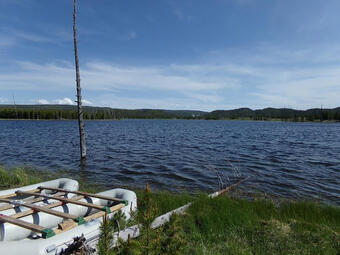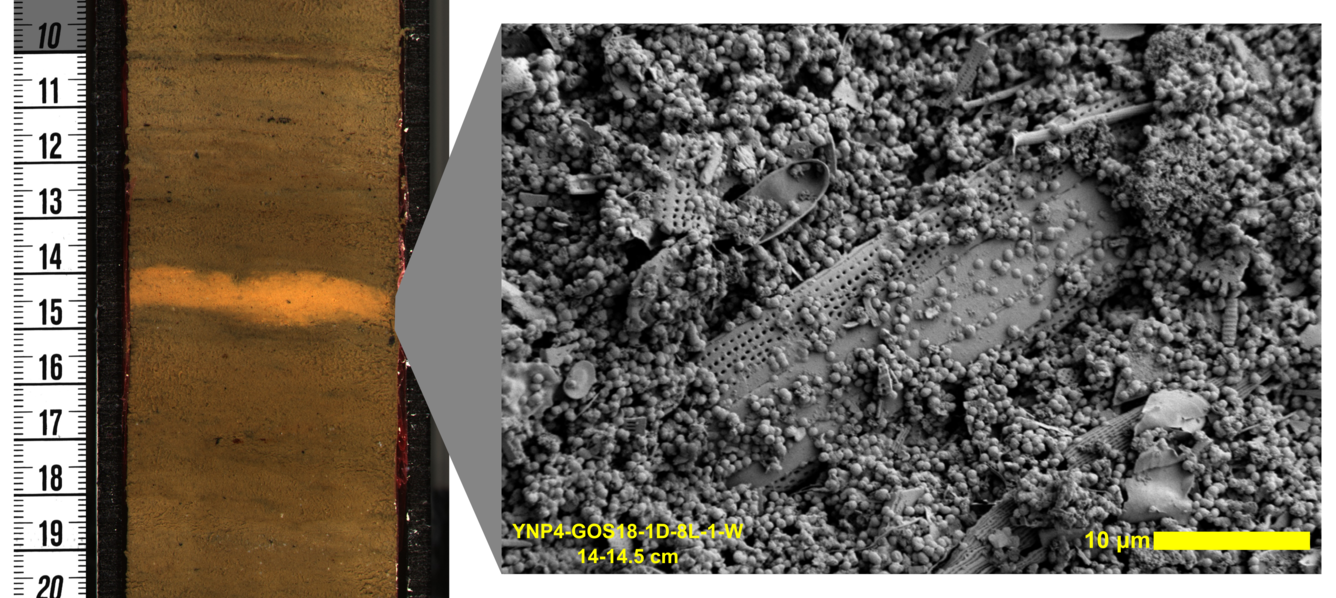
View of Lower Geyser Basin. Note active thermal pools (Great Fountain Geyser) in the foreground with thermal grasslands—kept treeless by hot soils—and lodgepole pine forest in the distance/George Marler, 1959
Editor's note: Yellowstone Caldera Chronicles is a weekly column written by scientists and collaborators of the Yellowstone Volcano Observatory. This contribution is from Christopher Schiller, postdoctoral scholar with the Department of Biology at the University of Washington, and Cathy Whitlock, Professor and Director of the Paleoecology Laboratory at Montana State University.
Today, Lower Geyser Basin in Yellowstone National Park is a treeless plain characterized by steaming ground, geysers, and mudpots. But thousands of years ago, it was heavily forested with less hydrothermal activity. Lake sediments tell the tale.
Lower Geyser Basin is the largest thermal basin in Yellowstone National Park (~14 km2 [5.5 mi2] of actively hot area) and includes some of the Park’s most famous hydrothermal features, like Fountain Paint Pots, Firehole Lake, and Great Fountain Geyser. It’s a landscape with a complicated past, sculpted by rhyolite lava flows, glaciers, hydrothermal activity, and climate change. Today, visitors see a flat, grassy landscape, where lodgepole pine cannot grow due to the hot ground.
In 2018, a research team from Montana State University collected an 8.08 m (26.5 ft) sediment core from Goose Lake, in Lower Geyser Basin, to study how the ecosystem of the area was impacted by hydrothermal activity. The scientists studied a variety of fossils, as well as the lithology and geochemistry of the cores to reconstruct the environmental history. Pollen and charcoal were examined to reconstruct the vegetation and fire history, and diatoms (siliceous algae) documented changes in lake biology. The physical and chemical properties of the cores also provided information on past hydrothermal activity.
Later in the record (after 3,800 years ago), the landscape changed dramatically. First, pollen and charcoal data suggest an abrupt shift to a landscape with open grassland or steppe—much more similar to Lower Geyser Basin today. This open landscape is maintained by soils that are heated by hydrothermal activity below the surface (the grasses and herbs that thrive in Lower Geyser Basin today can take the heat, but lodgepole pine cannot!), suggesting that hydrothermal activity became widespread in Lower Geyser Basin about 3,800 years ago. At the same time, Goose Lake sediments ceased to be arsenic-rich and heat- and alkalinity-adapted diatoms declined, suggesting that hydrothermal activity at Goose Lake itself ceased.
It seems, then, that Lower Geyser Basin changed dramatically around 3,800 years ago, with hydrothermal activity stopping in some locations, like Goose Lake, but becoming widespread throughout the basin. Hydrothermal areas change due to a variety of factors. The 1959 Hebgen Lake earthquake, for example, disrupted hydrothermal features throughout the Yellowstone, including within Lower Geyser Basin. Periods of drought also impact hydrothermal features, such as a period around 650 to 800 years ago when eruptions stopped at Old Faithful Geyser during a severe, sustained drought. An earthquake or severe drought are both possible causes of the reorganization of Lower Geyser Basin around 3,800 years ago.
Yellowstone has been called a geo-ecosystem, since it is strongly influenced by geological processes, like volcanism, hydrothermal activity, faulting, and tectonic uplift, as well as changes in climate and hydrology. The Goose Lake data show how closely tied geological, climatic, and ecological forces were in the creation of Yellowstone’s iconic thermal areas. If you would like to read more about this work into the ecosystem changes at Lower Geyser Basin over time, see the recent research article in the journal Quaternary Research at https://doi.org/10.1017/qua.2021.42.



 Support Essential Coverage of Essential Places
Support Essential Coverage of Essential Places




Comments
Interesting to read about the fluorite. I was in a Tertiary (I think) crater north of Rome (Italy) in 1970 sampling a thick deposit of fluorite insde the crater (severtal tens of metres thick, from memory), with local layers of gastropodes that obviously lived there and then. The in-situ CaF2 grade was 40% or 50%, but it was so fine-grained that it proved impossible to produce a commercial concentrate of >60%.
Soryy, I have forgotten the name of the place.